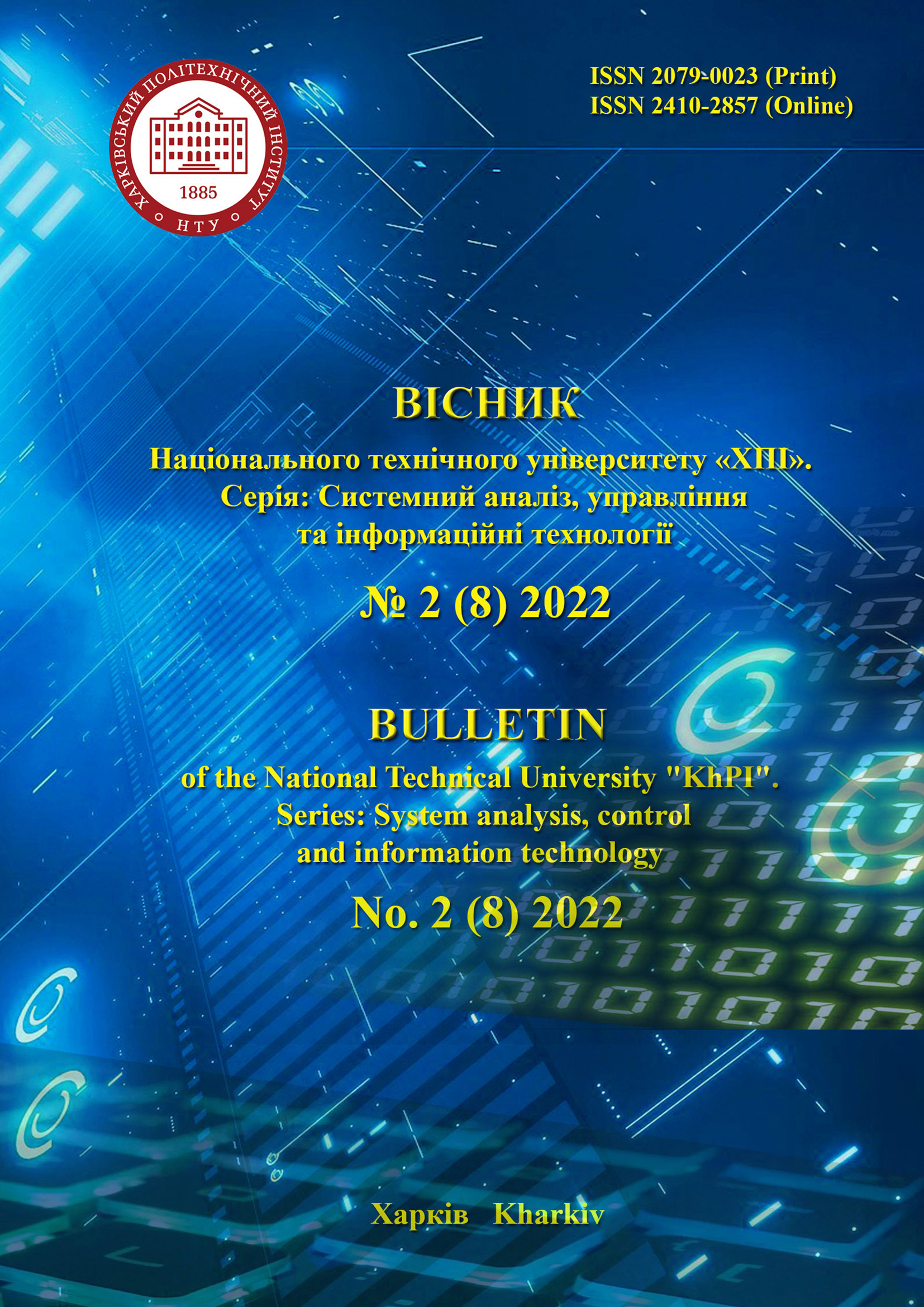MODIFIED METHOD OF CONSTRUCTING A MULTIVARIATE LINEAR REGRESSION GIVEN BY A REDUNDANT DESCRIPTION
DOI:
https://doi.org/10.20998/2079-0023.2022.02.01Keywords:
multivariate linear regression, least squares method, redundant description, cluster analysis, active experiment, linguistic variableAbstract
A number of scientific works of Prof. O. A. Pavlov and his disciples is devoted to the development of an original method of efficient estimation of coefficients at nonlinear terms of multivariate polynomial regression given by a redundant description under the conditions of an active experiment. The solution of the formulated problem is reduced to the sequential construction of univariate polynomial regressions (finding efficient estimates for the coefficients at nonlinear terms) and solving the corresponding systems of linear nondegenerate equations, the variables of which are the estimates for coefficients at nonlinear terms of the multivariate polynomial regression given by the redundant description. Thus, the problem was reduced to the estimation of the coefficients at linear terms of a multivariate linear regression given by a redundant description in the conditions of an active experiment. We have proposed an original method of its solution that uses a cluster analysis algorithm. The algorithm’s implementation significantly reduces the enumeration of partial descriptions of multivariate linear regression followed by the finding of the residual sum of squares for each of them. This allows using the chi-squared criterion to build a linguistic variable which value gives a qualitative assessment (high reliability, acceptable reliability, low reliability, unreliability) to the obtained result. The analysis of the computational experiments made it possible to modify the proposed method, which significantly increased its efficiency, first of all, of finding a reliable structure of the sought multivariate linear regression given by the redundant description. The method modification, in particular, has reduced the enumeration of partial descriptions and has led to a more efficient use of the general procedure of the least squares method.
References
Yu L. Using negative binomial regression analysis to predict software faults: a study of Apache Ant. International Journal of Information Technology and Computer Science (IJITCS). 2012, vol. 4, no. 8, pp. 63–70. doi: 10.5815/ijitcs.2012.08.08
Shahrel M.Z., Mutalib S., Abdul-Rahman S. PriceCop – price monitor and prediction using linear regression and LSVM-ABC methods for e-commerce platform. International Journal of Information Engineering and Electronic Business (IJIEEB). 2021, vol. 13, no. 1, pp. 1–14. doi: 10.5815/ijieeb.2021.01.01
Satter A., Ibtehaz N. A regression based sensor data prediction technique to analyze data trustworthiness in cyber-physical system. International Journal of Information Engineering and Electronic Business (IJIEEB). 2018, vol. 10, no. 3, pp. 15–22. doi: 10.5815/ ijieeb.2018.03.03
Isabona J., Ojuh D. O. Machine learning based on kernel function controlled gaussian process regression method for in-depth extrapolative analysis of Covid-19 daily cases drift rates. International Journal of Mathematical Sciences and Computing (IJMSC). 2021, vol. 7, No. 2, pp. 14–23. doi: 10.5815/ ijmsc.2021.02.02
Sinha P. Multivariate polynomial regression in data mining: methodology, problems and solutions. International Journal of Scientific & Engineering Research. 2013, vol. 4, iss. 12, pp. 962–965
Kalivas J. H. Interrelationships of multivariate regression methods using eigenvector basis sets. Journal of Chemometrics. 1999, vol. 13 (2), pp. 111–132. doi: 10.1002/(SICI)1099-128X(199903/ 04)13:2<111::AID-CEM532>3.0.CO;2-N
Ortiz-Herrero L., Maguregui M. I., Bartolomé L. Multivariate (O)PLS regression methods in forensic dating. TrAC Trends in Analytical Chemistry. 2021, vol. 141, 116278. doi: 10.1016/ j.trac.2021.116278
Guo G., Niu G., Shi Q. et al. Multi-element quantitative analysis of soils by laser induced breakdown spectroscopy (LIBS) coupled with univariate and multivariate regression methods. Analytical Methods. 2019, vol. 11, iss. 23, pp. 3006–3013, doi: 10.1039/C9AY00890J.
Babatunde G., Emmanuel A. A., Oluwaseun O. R., Bunmi O. B., Precious A. E. Impact of climatic change on agricultural product yield using k-means and multiple linear regressions. International Journal of Education and Management Engineering (IJEME). 2019, vol. 9, no. 3, pp. 16–26. doi: 10.5815/ijeme.2019.03.02
Pavlov A. A. Holovchenko M. N., Drozd V. V. Construction of a multivariate polynomial given by a redundant description in stochastic and deterministic formulations using an active experiment. Visnyk Nats. tekhn. un-tu "KhPI": zb. nauk. pr. Temat. vyp.: Systemnyy analiz, upravlinnya ta informatsiyni tekhnologiyi [Bulletin of the National Technical University "KhPI": a collection of scientific papers. Thematic issue: System analysis, management and information technology]. Kharkov, NTU "KhPI" Publ., 2022, no. 1 (7), pp. 3–8. doi: 10.20998/2079-0023.2022.01.01
Pavlov A., Holovchenko M., Mukha I., Lishchuk K. Mathematics and software for building nonlinear polynomial regressions using estimates for univariate polynomial regressions coefficients with a given (small) variance. Lecture Notes on Data Engineering and Communications Technologies. 2022, vol. 134, pp. 288–303. doi: 10.1007/978-3-031-04812-8_25
Pavlov O. A., Holovchenko M. M., Revych M. M. Metod otsinky koefitsiyentiv pry liniynykh chlenakh bahatovymirnoyi polinomial'noyi rehresiyi, zadanoyi nadlyshkovym opysom. [Method for estimating coefficients for linear terms of multidimensional polynomial regression given by redundant description] Adaptyvni systemy avtomatychnoho upravlinnya: mizhvidomchyy nauk.-tekhn. zbirnyk [Adaptive systems of automatic control: interdepartmental scientific and technical. collection]. Kyiv, NTUU "KPI" Publ., 2022, vol. 1, no. 40, pp. 110–117. doi: 10.20535/1560- 8956.40.2022.261665
Downloads
Published
How to Cite
Issue
Section
License
LicenseAuthors who publish with this journal agree to the following terms:
- Authors retain copyright and grant the journal right of first publication with the work simultaneously licensed under a Creative Commons Attribution License that allows others to share the work with an acknowledgement of the work's authorship and initial publication in this journal.
- Authors are able to enter into separate, additional contractual arrangements for the non-exclusive distribution of the journal's published version of the work (e.g., post it to an institutional repository or publish it in a book), with an acknowledgement of its initial publication in this journal.
- Authors are permitted and encouraged to post their work online (e.g., in institutional repositories or on their website) prior to and during the submission process, as it can lead to productive exchanges, as well as earlier and greater citation of published work (See The Effect of Open Access).


